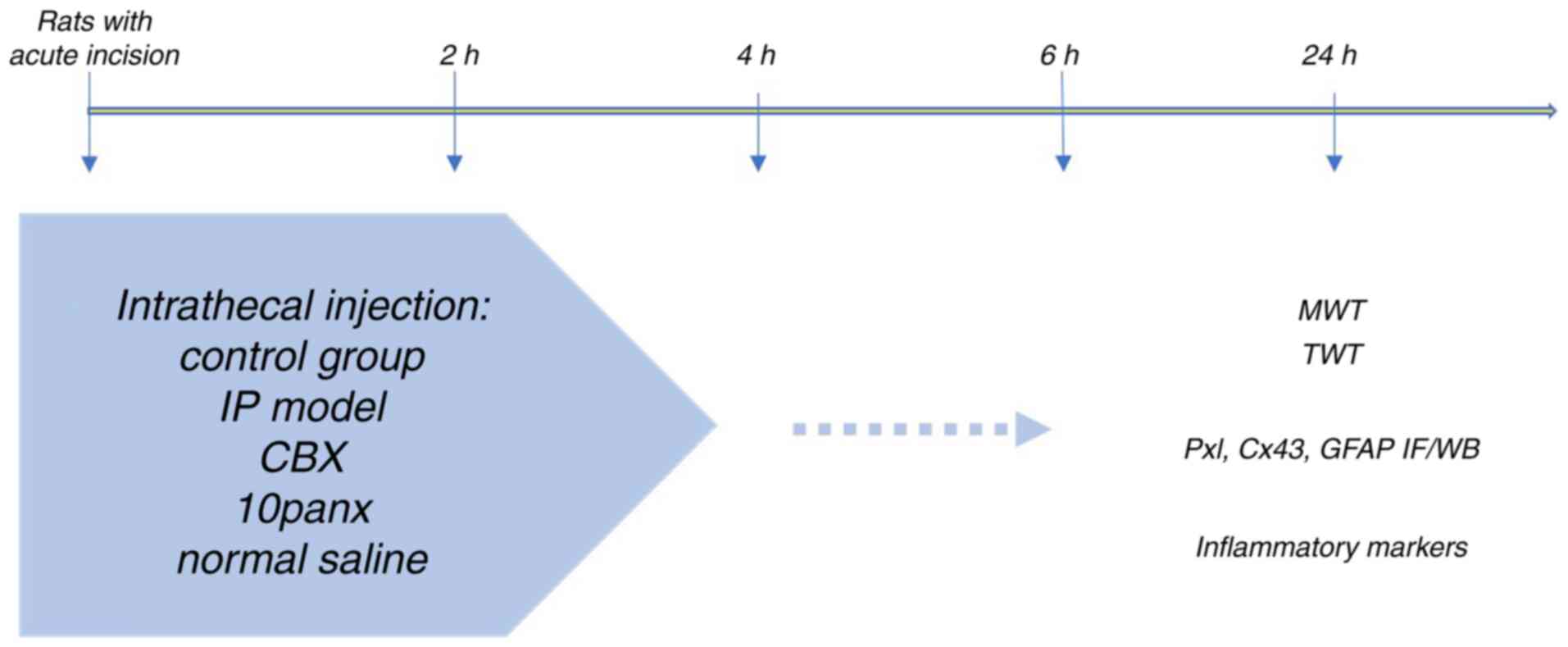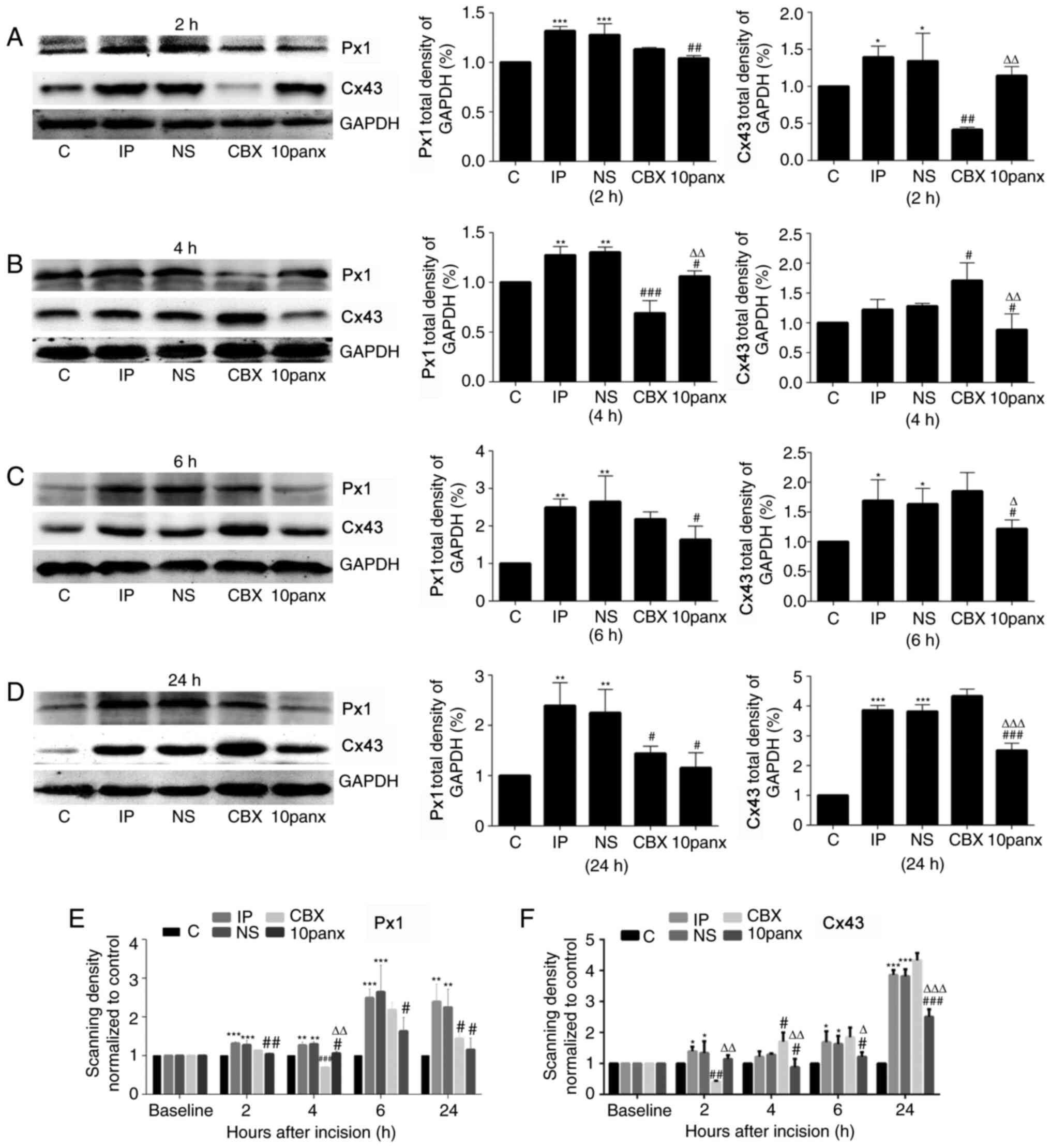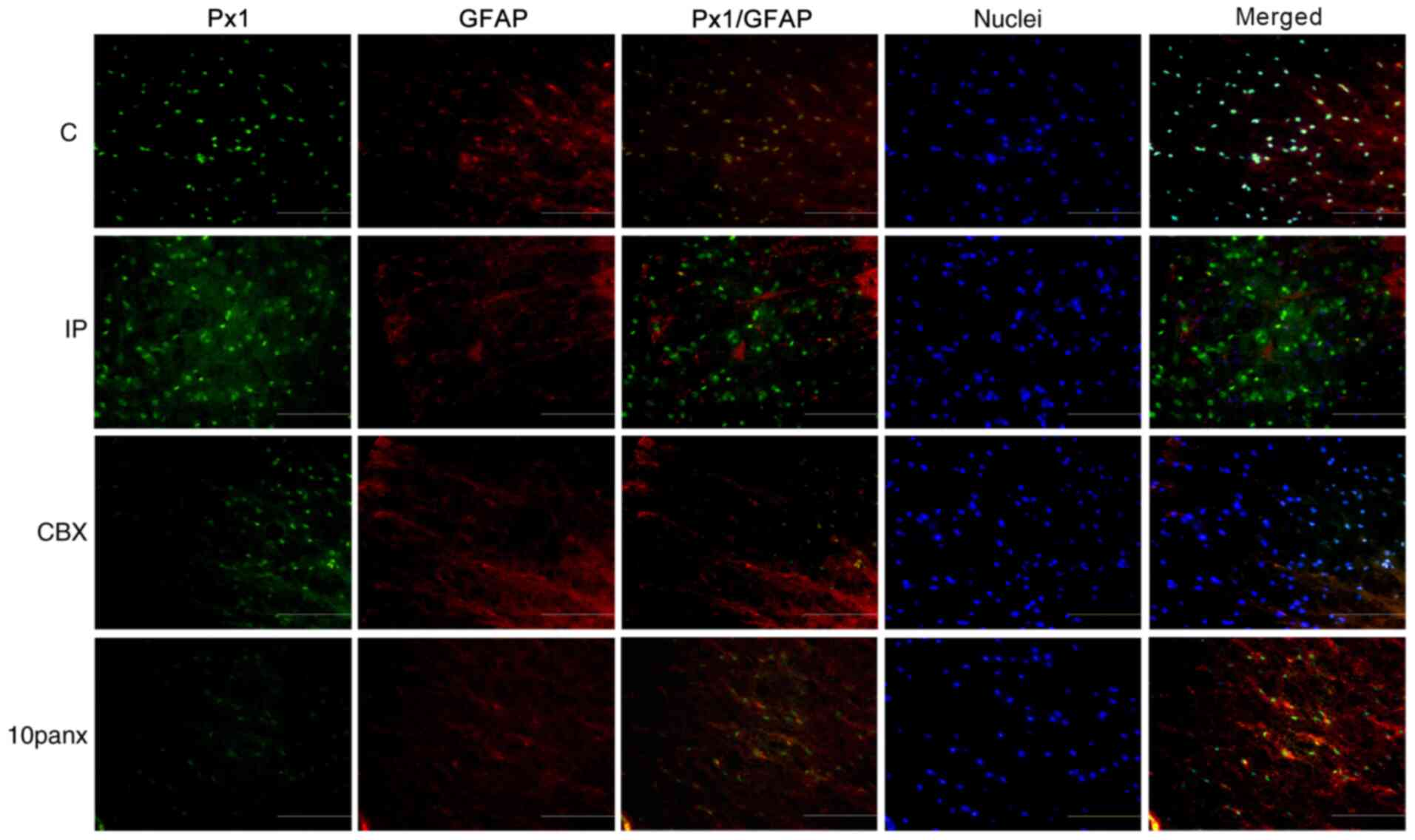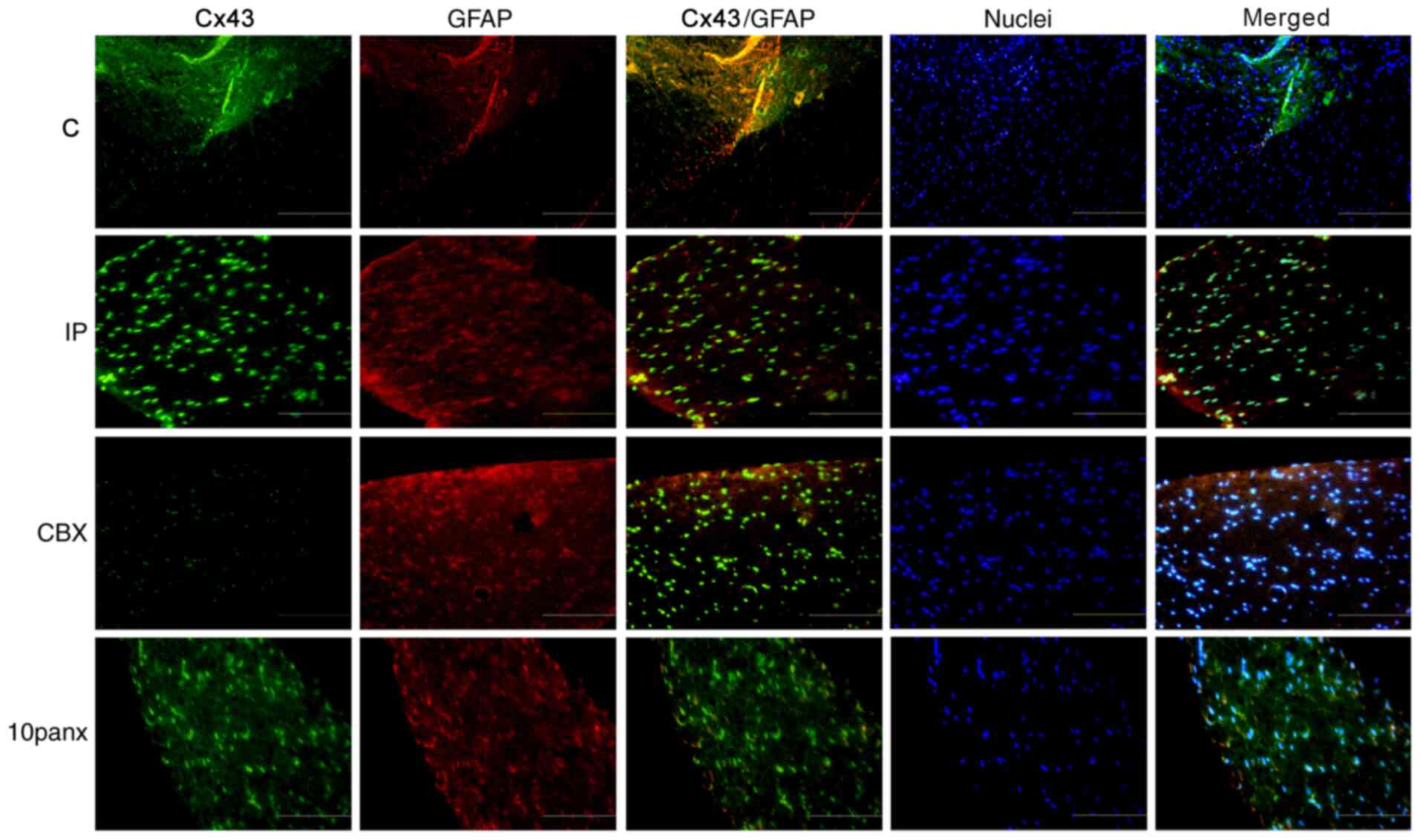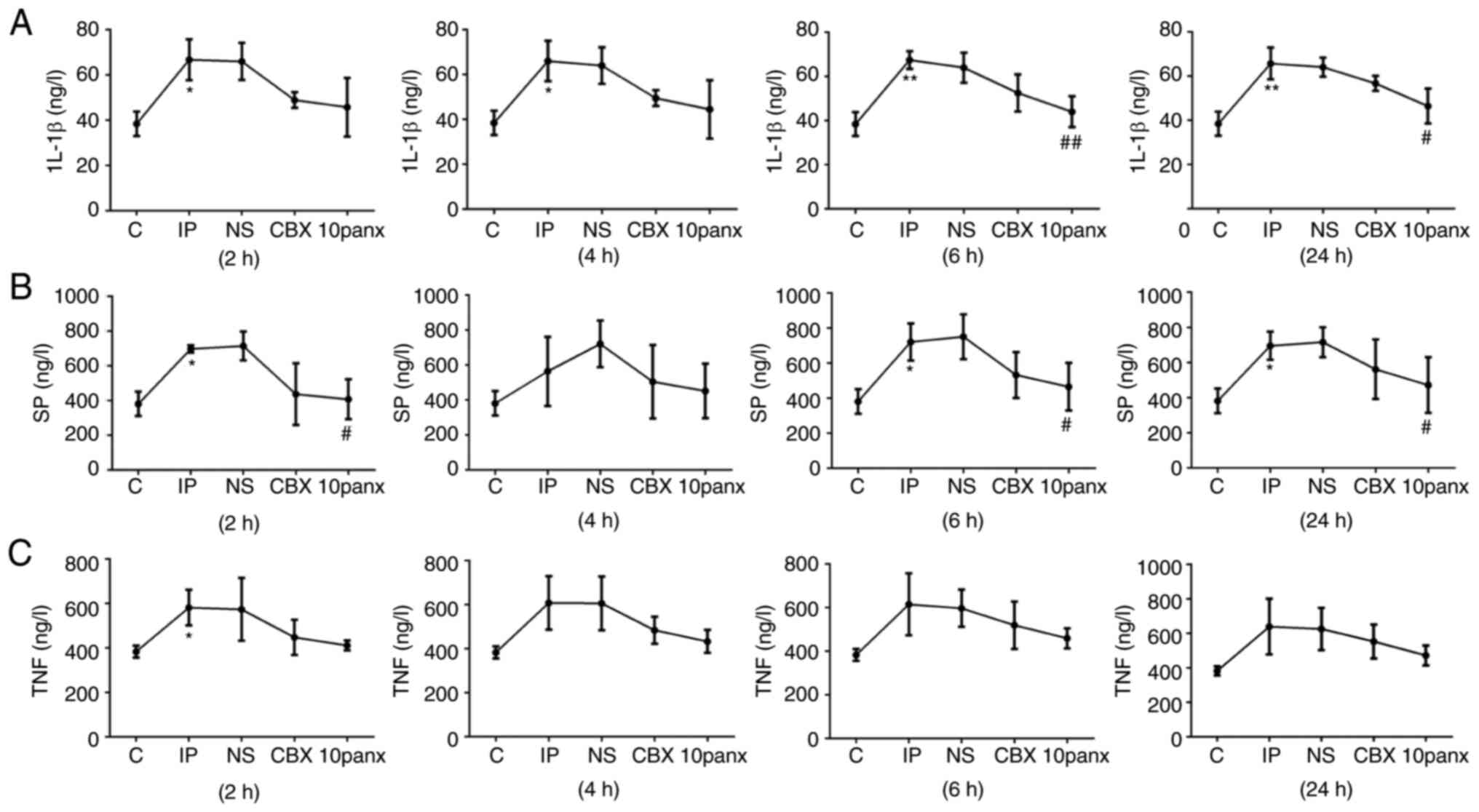|
1
|
Kehlet H: Postoperative pain, analgesia,
and recovery-bedfellows that cannot be ignored. Pain. 159 (Suppl
1):S11–S16. 2018. View Article : Google Scholar : PubMed/NCBI
|
|
2
|
Ji RR, Chamessian A and Zhang YQ: Pain
regulation by non-neuronal cells and inflammation. Science.
354:572–577. 2016. View Article : Google Scholar : PubMed/NCBI
|
|
3
|
Peng J, Gu N, Zhou L, B Eyo U, Murugan M,
Gan WB and Wu LJ: Microglia and monocytes synergistically promote
the transition from acute to chronic pain after nerve injury. Nat
Commun. 7:120292016. View Article : Google Scholar : PubMed/NCBI
|
|
4
|
Ramani M, Mylvaganam S, Krawczyk M, Wang
L, Zoidl C, Brien J, Reynolds JN, Kapur B, Poulter MO, Zoidl G and
Carlen PL: Differential expression of astrocytic connexins in a
mouse model of prenatal alcohol exposure. Neurobiol Dis. 91:83–93.
2016. View Article : Google Scholar : PubMed/NCBI
|
|
5
|
Dahl G and Muller KJ: Innexin and pannexin
channels and their signaling. FEBS Lett. 588:1396–1402. 2014.
View Article : Google Scholar : PubMed/NCBI
|
|
6
|
Garre JM, Yang G, Bukauskas FF and Bennett
MV: FGF-1 triggers pannexin-1 hemichannel opening in spinal
astrocytes of rodents and promotes inflammatory responses in acute
spinal cord slices. J Neurosci. 36:4785–4801. 2016. View Article : Google Scholar : PubMed/NCBI
|
|
7
|
Bargiotas P, Krenz A, Hormuzdi SG, Ridder
DA, Herb A, Barakat W, Penuela S, von Engelhardt J, Monyer H and
Schwaninger M: Pannexins in ischemia-induced neurodegeneration.
Proc Natl Acad Sci USA. 108:20772–20777. 2011. View Article : Google Scholar : PubMed/NCBI
|
|
8
|
Reyes EP, Cerpa V, Corvalán L and Retamal
MA: Cxs and Panx-hemichannels in peripheral and central
chemosensing in mammals. Front Cell Neurosci. 8:1232014. View Article : Google Scholar : PubMed/NCBI
|
|
9
|
Zhang Y, Laumet G, Chen SR, Hittelman WN
and Pan HL: Pannexin-1 Up-regulation in the dorsal root ganglion
contributes to neuropathic pain development. J Biol Chem.
290:14647–14655. 2015. View Article : Google Scholar : PubMed/NCBI
|
|
10
|
Burma NE, Bonin RP, Leduc-Pessah H, Baimel
C, Cairncross ZF, Mousseau M, Shankara JV, Stemkowski PL,
Baimoukhametova D, Bains JS, et al: Blocking microglial pannexin-1
channels alleviates morphine withdrawal in rodents. Nat Med.
23:355–360. 2017. View
Article : Google Scholar : PubMed/NCBI
|
|
11
|
Hanstein R, Hanani M, Scemes E and Spray
DC: Glial pannexin1 contributes to tactile hypersensitivity in a
mouse model of orofacial pain. Sci Rep. 6:382662016. View Article : Google Scholar : PubMed/NCBI
|
|
12
|
Bravo D, Ibarra P, Retamal J, Pelissier T,
Laurido C, Hernandez A and Constandil L: Pannexin 1: A novel
participant in neuropathic pain signaling in the rat spinal cord.
Pain. 155:2108–2115. 2014. View Article : Google Scholar : PubMed/NCBI
|
|
13
|
Michalski K and Kawate T: Carbenoxolone
inhibits Pannexin1 channels through interactions in the first
extracellular loop. J Gen Physiol. 147:165–174. 2016. View Article : Google Scholar : PubMed/NCBI
|
|
14
|
Morioka N, Nakamura Y, Zhang FF,
Hisaoka-Nakashima K and Nakata Y: Role of connexins in chronic pain
and their potential as therapeutic targets for next-generation
analgesics. Biol Pharm Bull. 42:857–866. 2019. View Article : Google Scholar : PubMed/NCBI
|
|
15
|
D'Hondt C, Iyyathurai J, Himpens B,
Leybaert L and Bultynck G: Cx43-hemichannel function and regulation
in physiology and pathophysiology: Insights from the bovine corneal
endothelial cell system and beyond. Front Physiol. 5:3482014.
View Article : Google Scholar
|
|
16
|
Dierks A, Bader A, Lehrich T and Ngezahayo
A: Stimulation of the A2B adenosine receptor subtype
enhances connexin26 hemichannel activity in small airway epithelial
cells. Cell Physiol Biochem. 53:606–622. 2019. View Article : Google Scholar : PubMed/NCBI
|
|
17
|
Treede RD: The international association
for the study of pain definition of pain: As valid in 2018 as in
1979, but in need of regularly updated footnotes. Pain Rep.
3:e6432018. View Article : Google Scholar : PubMed/NCBI
|
|
18
|
Roh DH, Yoon SY, Seo HS, Kang SY, Han HJ,
Beitz AJ and Lee JH: Intrathecal injection of carbenoxolone, a gap
junction decoupler, attenuates the induction of below-level
neuropathic pain after spinal cord injury in rats. Exp Neurol.
224:123–132. 2010. View Article : Google Scholar : PubMed/NCBI
|
|
19
|
Brennan TJ, Vandermeulen EP and Gebhart
GF: Characterization of a rat model of incisional pain. Pain.
64:493–502. 1996. View Article : Google Scholar : PubMed/NCBI
|
|
20
|
Zhao H, Alam A, Chen Q, A Eusman M, Pal A,
Eguchi S, Wu L and Ma D: The role of microglia in the pathobiology
of neuropathic pain development: What do we know? Br J Anaesth.
118:504–516. 2017. View Article : Google Scholar : PubMed/NCBI
|
|
21
|
Chu LW, Cheng KI, Chen JY, Cheng YC, Chang
YC, Yeh JL, Hsu JH, Dai ZK and Wu BN: Loganin prevents chronic
constriction injury-provoked neuropathic pain by reducing
TNF-α/IL-1β-mediated NF-κB activation and Schwann cell
demyelination. Phytomedicine. 67:1531662020. View Article : Google Scholar : PubMed/NCBI
|
|
22
|
de Boer HD, Detriche O and Forget P:
Opioid-related side effects: Postoperative ileus, urinary
retention, nausea and vomiting, and shivering. A review of the
literature. Best Pract Res Clin Anaesthesiol. 31:499–504. 2017.
View Article : Google Scholar : PubMed/NCBI
|
|
23
|
Deng GC, Lu M, Zhao YY, Yuan Y and Chen G:
Activated spinal astrocytes contribute to the later phase of
carrageenan-induced prostatitis pain. J Neuroinflammation.
16:1892019. View Article : Google Scholar : PubMed/NCBI
|
|
24
|
Robinson CR and Dougherty PM: Spinal
astrocyte gap junction and glutamate transporter expression
contributes to a rat model of bortezomib-induced peripheral
neuropathy. Neuroscience. 285:1–10. 2015. View Article : Google Scholar : PubMed/NCBI
|
|
25
|
Wieseler-Frank J, Maier SF and Watkins LR:
Glial activation and pathological pain. Neurochem Int. 45:389–395.
2004. View Article : Google Scholar : PubMed/NCBI
|
|
26
|
Chen MJ, Kress B, Han X, Moll K, Peng W,
Ji RR and Nedergaard M: Astrocytic CX43 hemichannels and gap
junctions play a crucial role in development of chronic neuropathic
pain following spinal cord injury. Glia. 60:1660–1670. 2012.
View Article : Google Scholar : PubMed/NCBI
|
|
27
|
O'Callaghan JP and Miller DB: Spinal glia
and chronic pain. Metabolism. 59 (Suppl 1):S21–S26. 2010.
View Article : Google Scholar
|
|
28
|
Xing L, Yang T, Cui S and Chen G: Connexin
hemichannels in astrocytes: Role in CNS disorders. Front Mol
Neurosci. 12:232019. View Article : Google Scholar : PubMed/NCBI
|
|
29
|
Wei H, Deng F, Chen Y, Qin Y, Hao Y and
Guo X: Ultrafine carbon black induces glutamate and ATP release by
activating connexin and pannexin hemichannels in cultured
astrocytes. Toxicology. 323:32–41. 2014. View Article : Google Scholar : PubMed/NCBI
|
|
30
|
Gdecke S, Roderigo C, Rose CR, Rauch BH,
Gödecke A and Schrader J: Thrombin-induced ATP release from human
umbilical vein endothelial cells. Am J Physiol Cell Physiol.
302:C915–C923. 2012. View Article : Google Scholar : PubMed/NCBI
|
|
31
|
Yoon SY, Robinson CR, Zhang H and
Dougherty PM: Spinal astrocyte gap junctions contribute to
oxaliplatin-induced mechanical hypersensitivity. J Pain.
14:205–214. 2013. View Article : Google Scholar : PubMed/NCBI
|
|
32
|
Di Cesare Mannelli L, Marcoli M, Micheli
L, Zanardelli M, Maura G, Ghelardini C and Cervetto C: Oxaliplatin
evokes P2X7-dependent glutamate release in the cerebral cortex: A
pain mechanism mediated by Pannexin 1. Neuropharmacology.
97:133–141. 2015. View Article : Google Scholar : PubMed/NCBI
|
|
33
|
Basova LV, Tang X, Umasume T, Gromova A,
Zyrianova T, Shmushkovich T, Wolfson A, Hawley D, Zoukhri D,
Shestopalov VI and Makarenkova HP: Manipulation of panx1 activity
increases the engraftment of transplanted lacrimal gland epithelial
progenitor cells. Invest Ophthalmol Vis Sci. 58:5654–5665. 2017.
View Article : Google Scholar : PubMed/NCBI
|
|
34
|
Wei R, Bao W, He F, Meng F, Liang H and
Luo B: Pannexin1 channel inhibitor (10panx) protects
against transient focal cerebral ischemic injury by inhibiting RIP3
expression and inflammatory response in rats. Neuroscience.
437:23–33. 2020. View Article : Google Scholar : PubMed/NCBI
|
|
35
|
Wang A and Xu C: The role of connexin43 in
neuropathic pain induced by spinal cord injury. Acta Biochim
Biophys Sin (Shanghai). 51:555–561. 2019. View Article : Google Scholar : PubMed/NCBI
|
|
36
|
Zhou L, Ao L, Yan Y, Li C, Li W, Ye A, Liu
J, Hu Y, Fang W and Li Y: Levo-corydalmine attenuates
vincristine-induced neuropathic pain in mice by upregulating the
Nrf2/HO-1/CO pathway to inhibit connexin 43 expression.
Neurotherapeutics. 17:340–355. 2020. View Article : Google Scholar : PubMed/NCBI
|
|
37
|
Vicario N, Pasquinucci L, Spitale FM,
Chiechio S, Turnaturi R, Caraci F, Tibullo D, Avola R, Gulino R,
Parenti R and Parenti C: Simultaneous activation of Mu and Delta
opioid receptors reduces allodynia and astrocytic connexin 43 in an
animal model of neuropathic pain. Mol Neurobiol. 56:7338–7354.
2019. View Article : Google Scholar : PubMed/NCBI
|
|
38
|
Jin YZ, Zhang P, Hao T, Wang LM, Guo MD
and Gan YH: Connexin 43 contributes to temporomandibular joint
inflammation induced-hypernociception via sodium channel 1.7 in
trigeminal ganglion. Neurosci Lett. 707:1343012019. View Article : Google Scholar : PubMed/NCBI
|
|
39
|
Liu X, Tonello R, Ling Y, Gao YJ and Berta
T: Paclitaxel-activated astrocytes produce mechanical allodynia in
mice by releasing tumor necrosis factor-α and stromal-derived cell
factor 1. J Neuroinflammation. 16:2092019. View Article : Google Scholar : PubMed/NCBI
|
|
40
|
Yan X, Li F, Maixner DW, Yadav R, Gao M,
Ali MW, Hooks SB and Weng HR: Interleukin-1beta released by
microglia initiates the enhanced glutamatergic activity in the
spinal dorsal horn during paclitaxel-associated acute pain
syndrome. Glia. 67:482–497. 2019. View Article : Google Scholar : PubMed/NCBI
|
|
41
|
Obata H, Sakurazawa S, Kimura M and Saito
S: Activation of astrocytes in the spinal cord contributes to the
development of bilateral allodynia after peripheral nerve injury in
rats. Brain Res. 1363:72–80. 2010. View Article : Google Scholar : PubMed/NCBI
|
|
42
|
Li X, Sun S, Wang Q and Zhao Z: Population
pharmacokinetics of combined intravenous and local intrathecal
administration of meropenem in aneurysm patients with suspected
intracranial infections after craniotomy. Eur J Drug Metab
Pharmacokinet. 43:45–53. 2018. View Article : Google Scholar : PubMed/NCBI
|
|
43
|
Ossipov MH, Morimura K and Porreca F:
Descending pain modulation and chronification of pain. Curr Opin
Support Palliat Care. 8:143–151. 2014. View Article : Google Scholar : PubMed/NCBI
|















